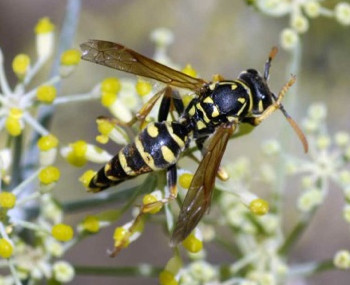A little color has disappeared from the landscape!
Almost beneath notice, two of our most colorful and common species have largely given way over the last few years to a smaller, less colorful cousin. Rust reds and louder golds have been replaced by more black-dominated and simpler bands of yellow. It’s not that you and I and almost everyone else hasn’t seen the change take place! It’s just that we have not paid close attention. Why? Our subject here is of pesky nuisances - paper wasps, not of flamboyant birds or bright flowers.

The northern paper wasp, Polistes fuscatus, was until recently our most common large paper wasp. Impressive in size and boldly banded with yellow markings on a black face and body, this paper wasp could be as readily found in our gardens as in natural scrub habitats, anywhere with abundant nectar sources for the adults and caterpillars for their larvae. Also present, though not nearly as abundant,, its very colorful relative P. apachus, which I shall call the southwestern paper wasp, has always been for me a visual treat. While both of these wasps are formidable, neither is aggressive unless their nest is closely threatened, making them a photographer’s ideal subject - easily approachable, colorful insects commonly found with equally colorful backdrops.
Both species have largely been replaced by an invasive species, the smaller European paper wasp, P. dominula. My first photos of this new-to-me species date to 2006, a time still dominated by our native paper wasps. These days, it will take a bit of searching to turn up anything but the European paper wasp. While I am sure the other two species will survive, it will take many years for the necessary environmental rebalance to occur because the ecological changes now under way as a result of this invasion are extensive and complex.
These Europeans take a wide range of insect food for their larvae, not just caterpillars as do the others. At first, this might seem good news for butterflies and moths, but the Euros are smaller, letting them hunt in tighter quarters, and they begin nesting earlier in the year than the others. Indeed the proliferation of these paper wasps may partially explain why butterflies have become so scarce recently. Wasp food!
So, next time you see one of these wasps hovering near a crevice, long legs a-dangle from her black and yellow banded body, take a closer look. She may be hunting for food or a nesting site. But what you will be seeing is ecological change on the wing.


